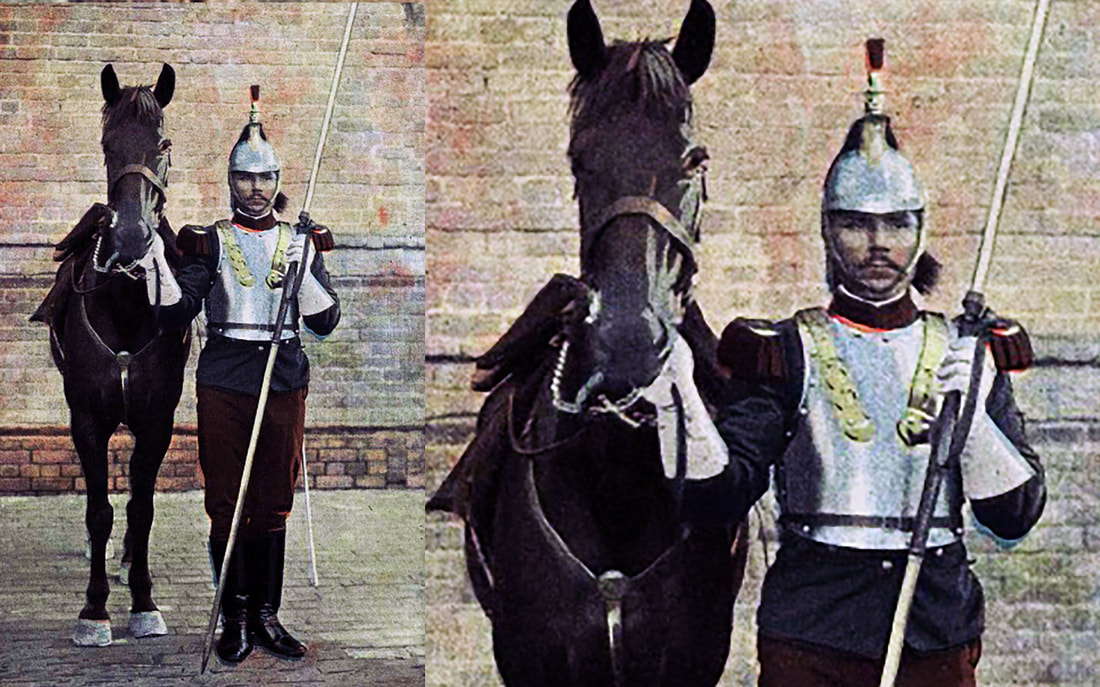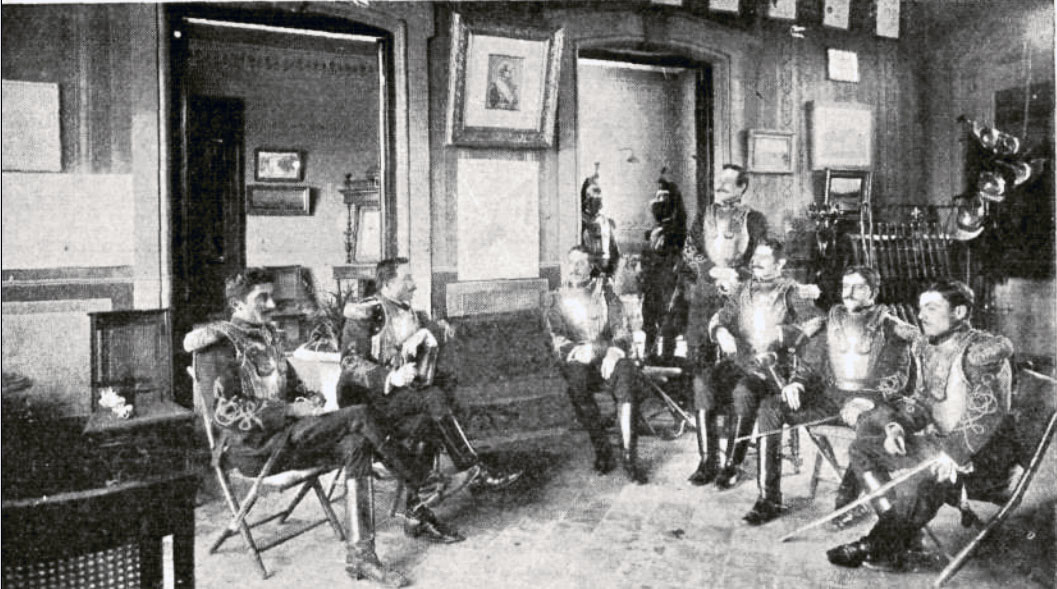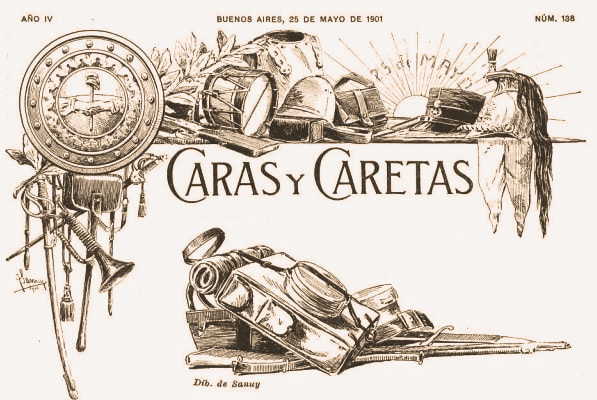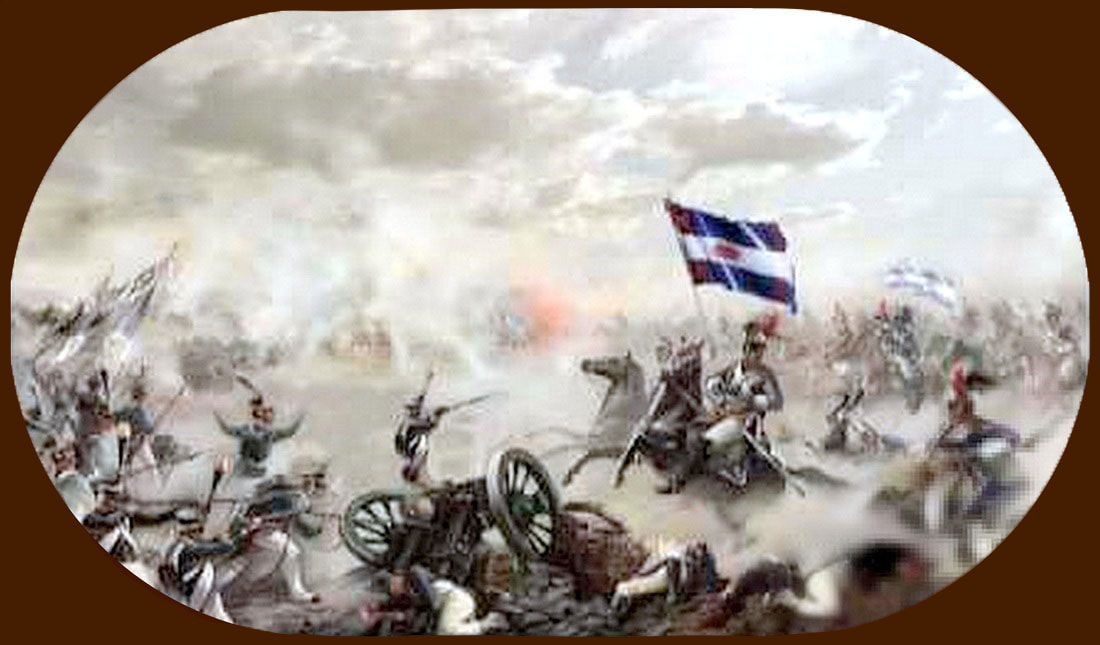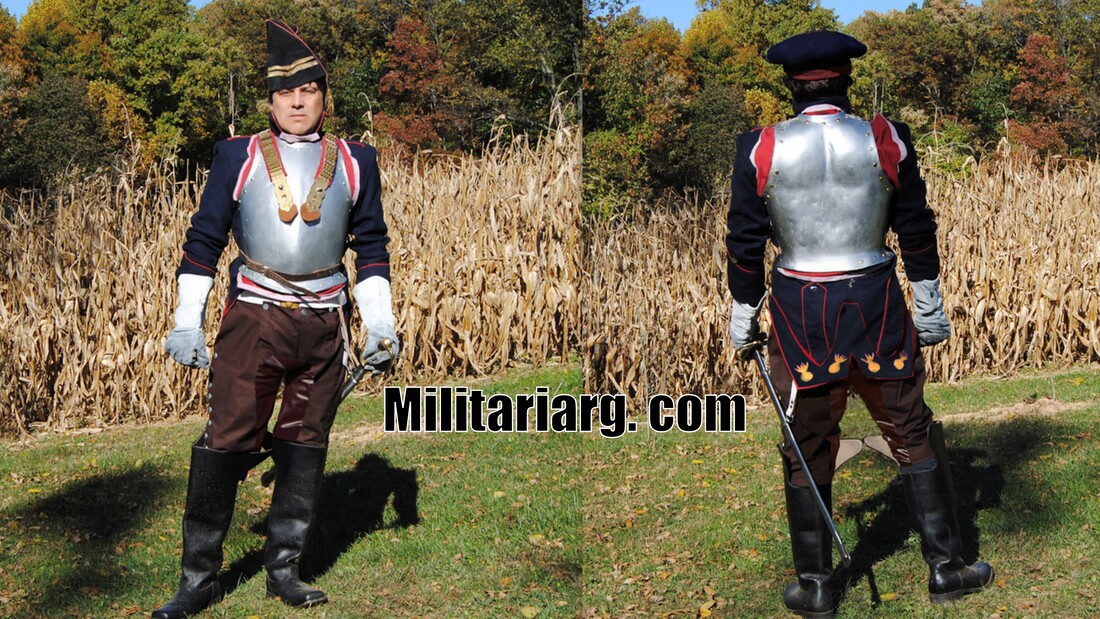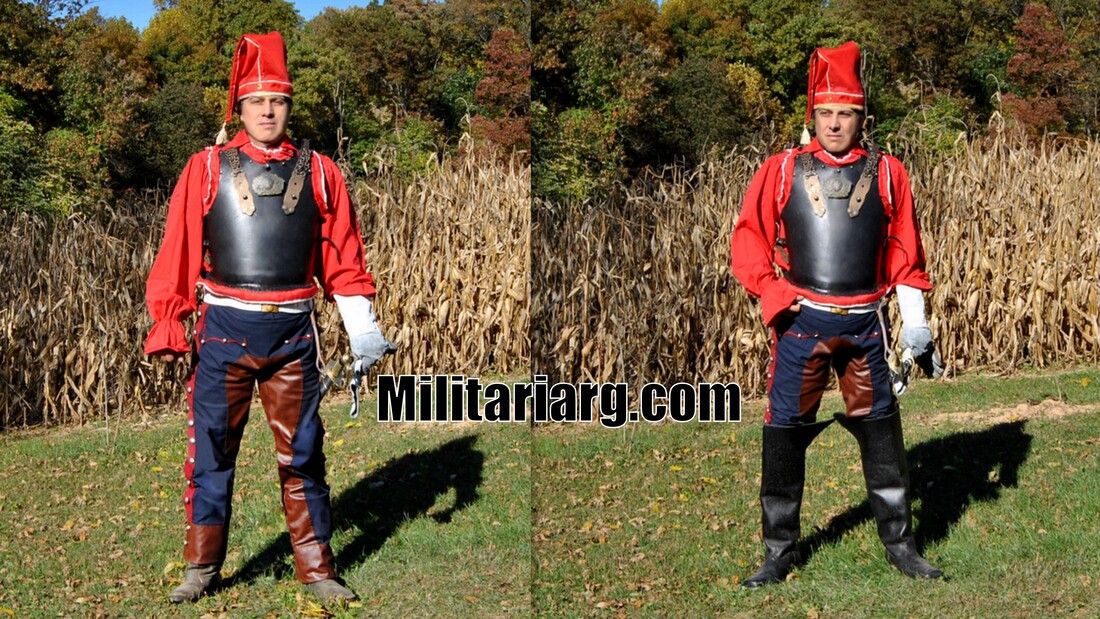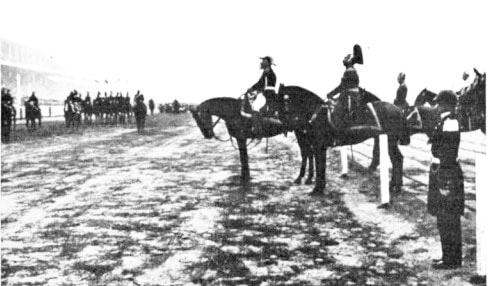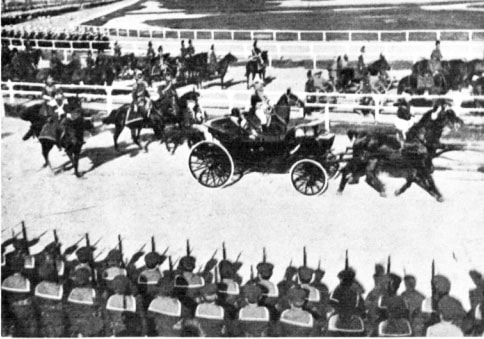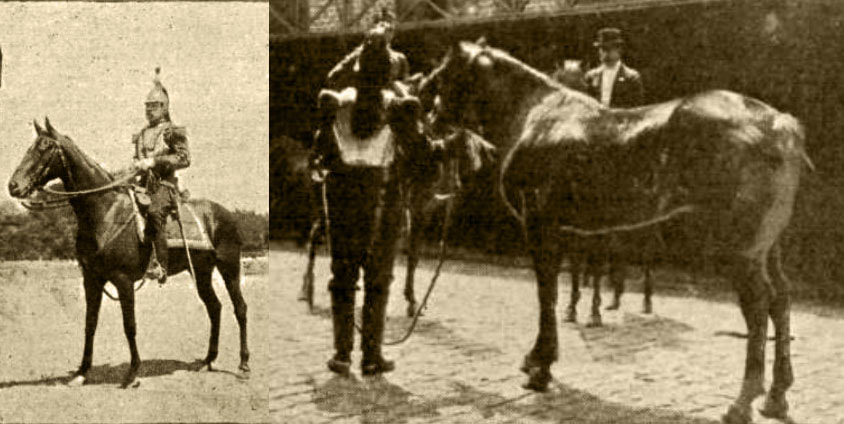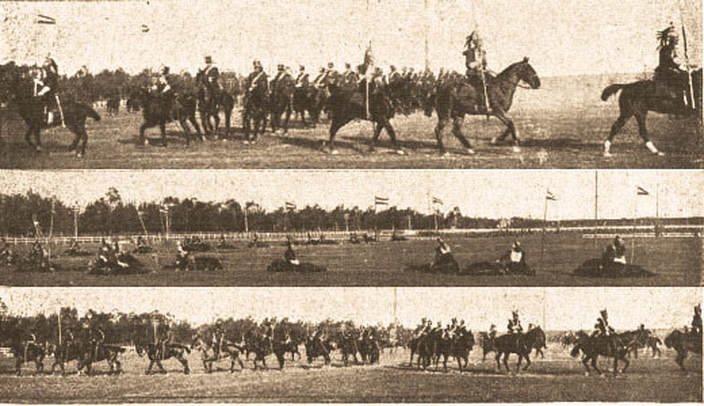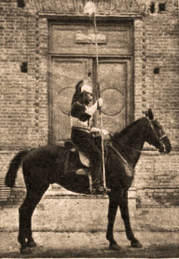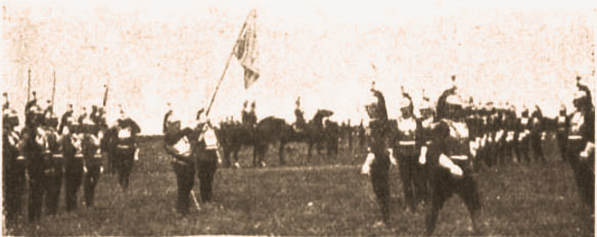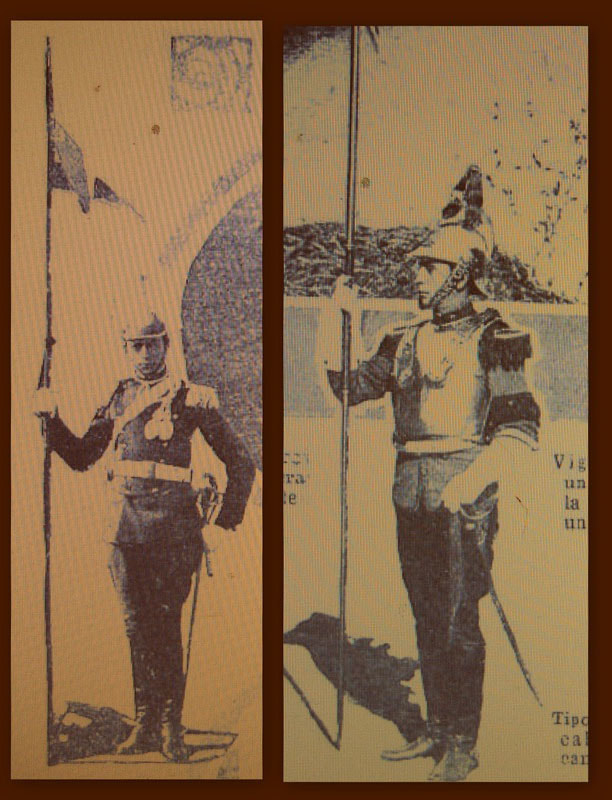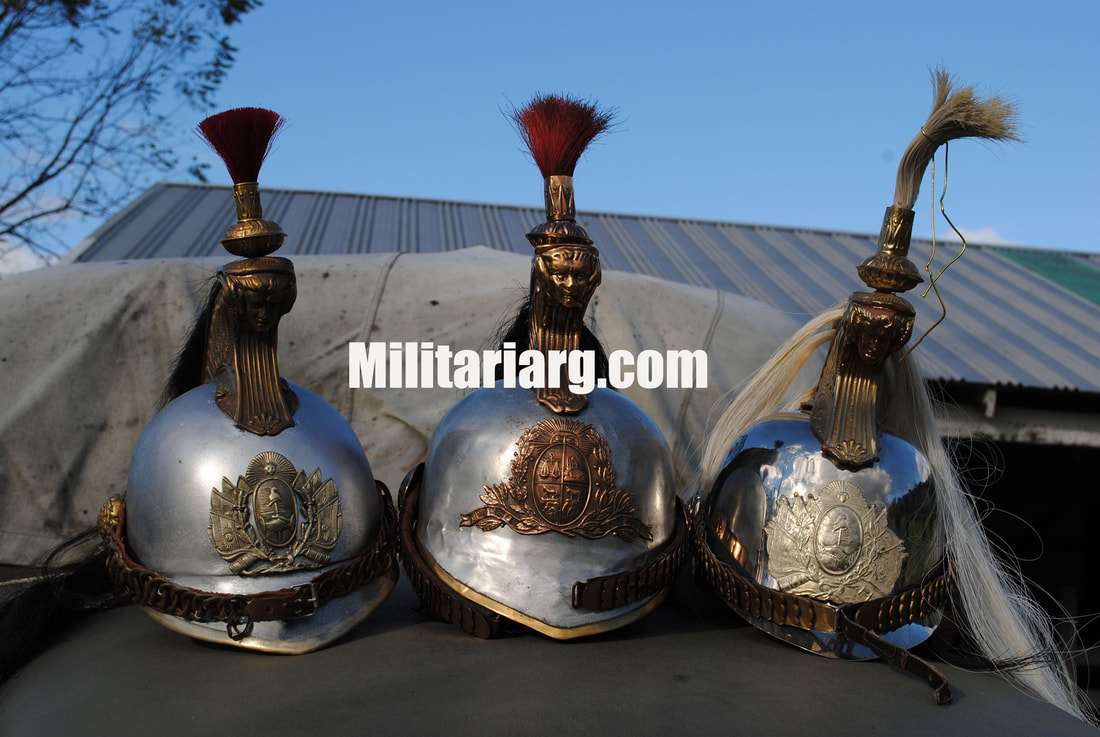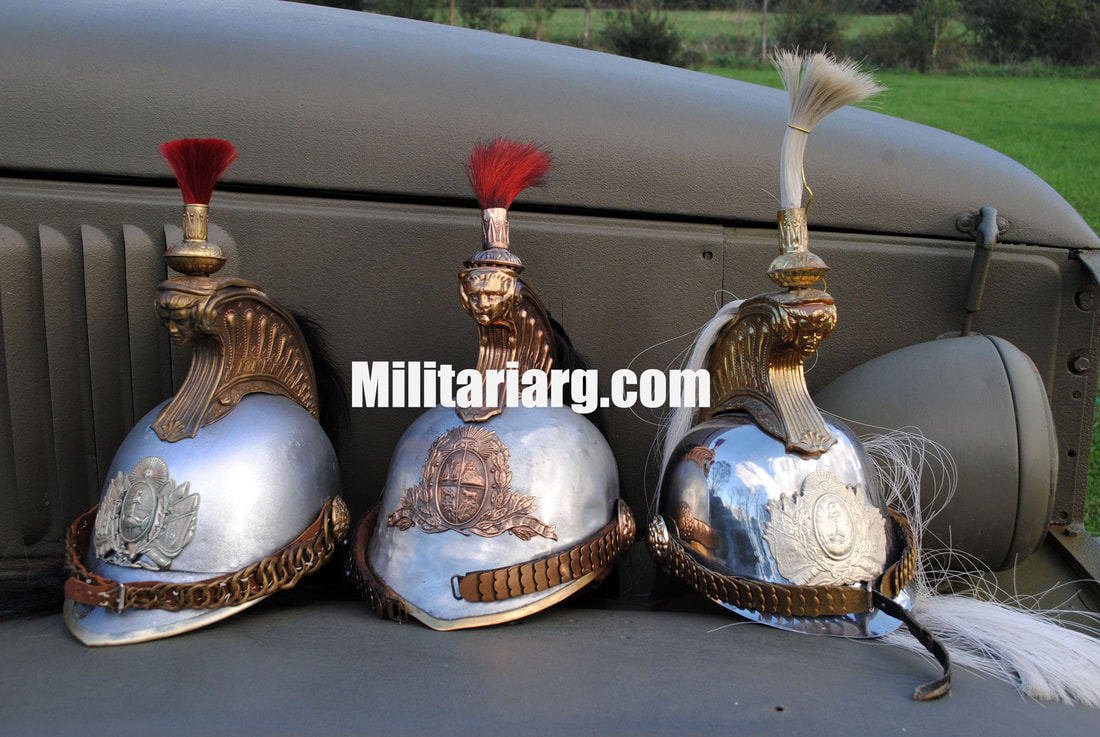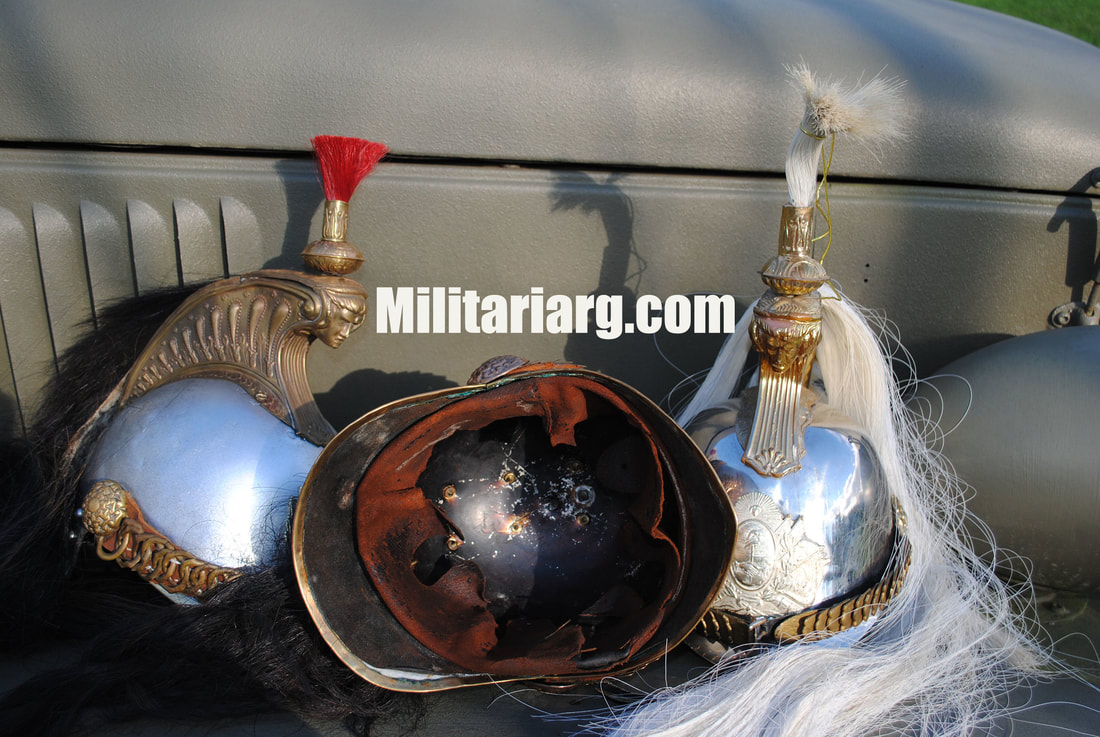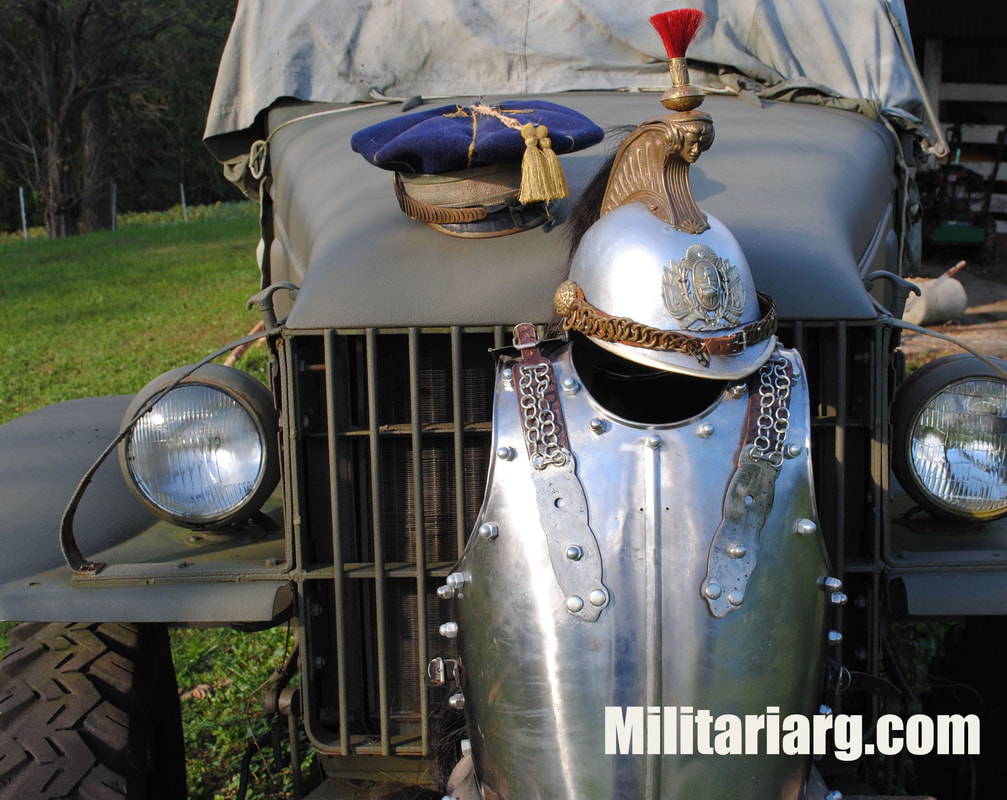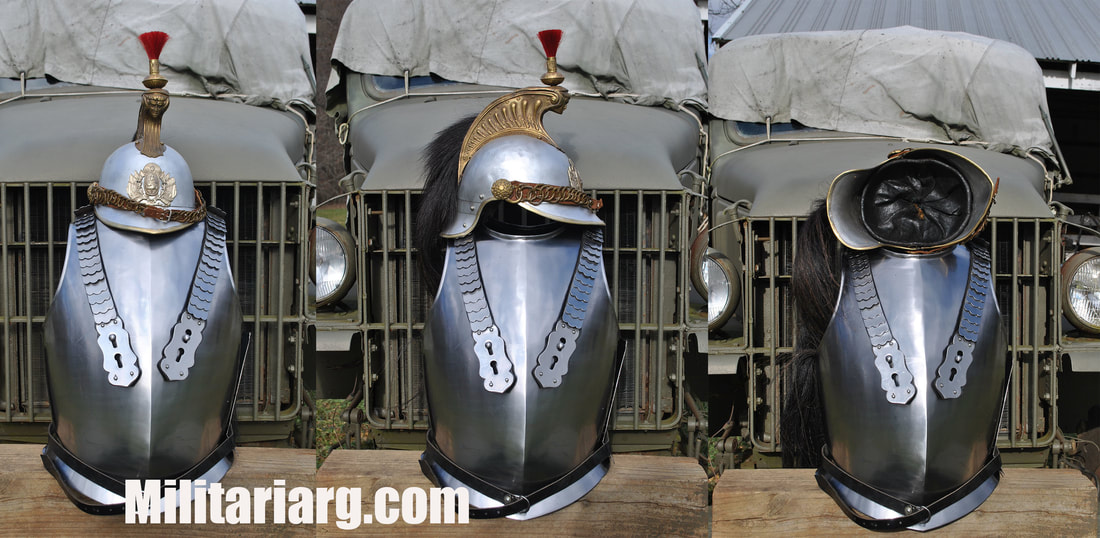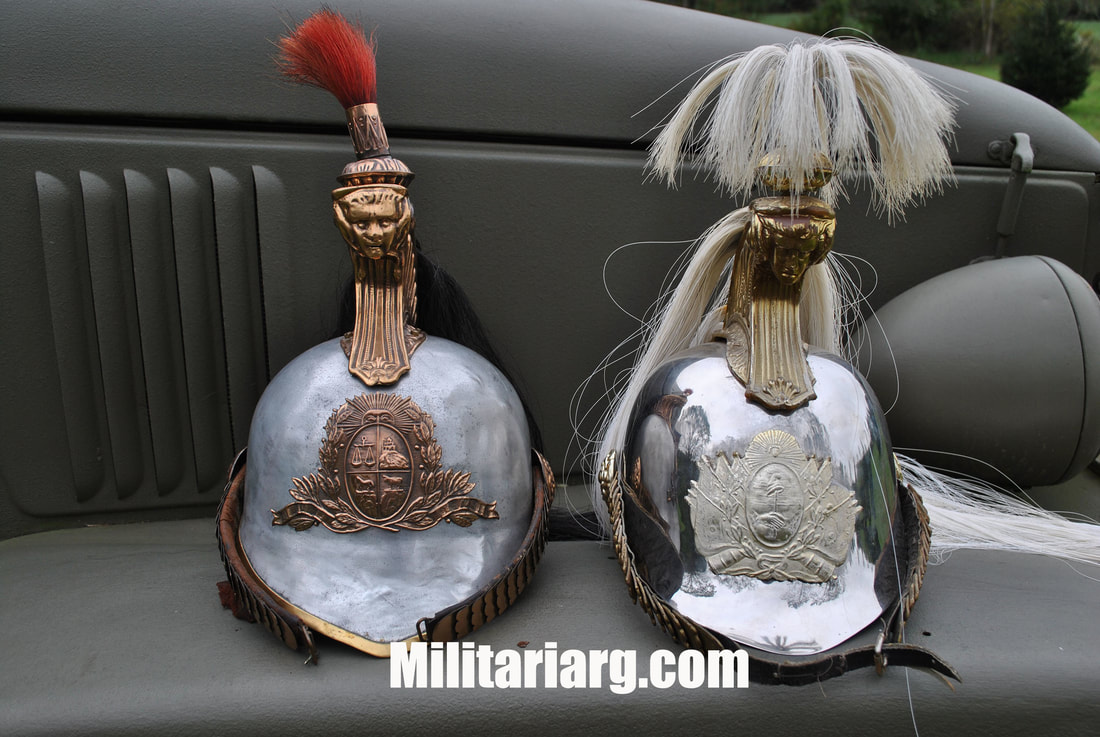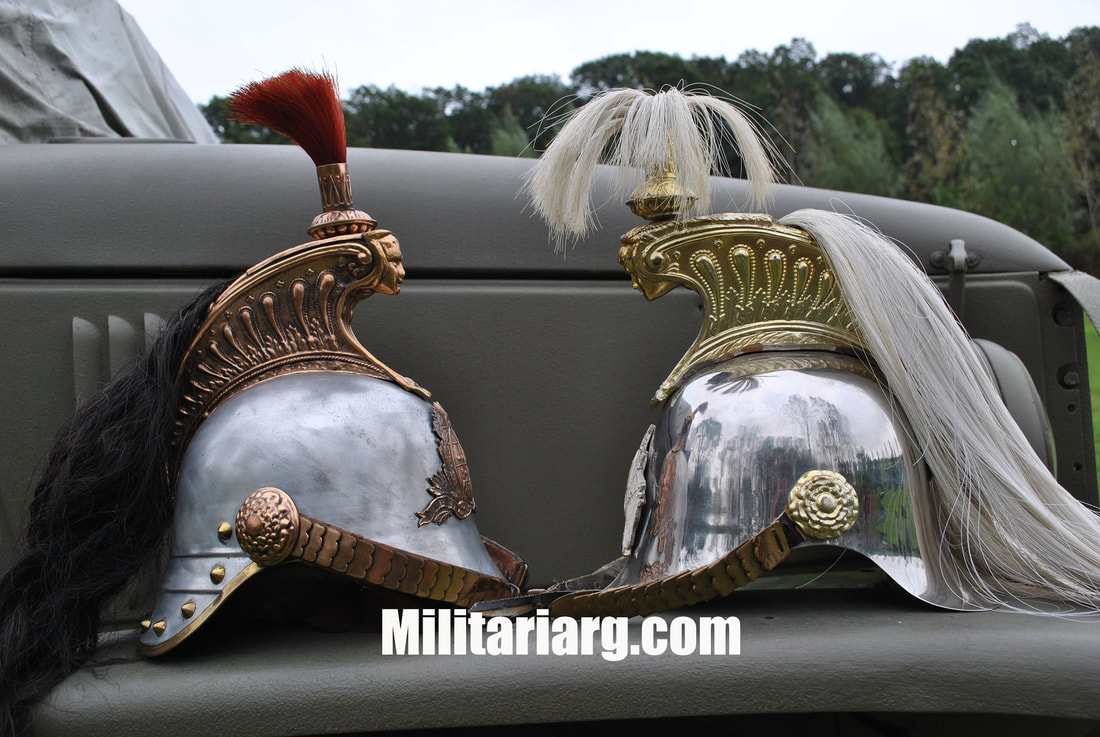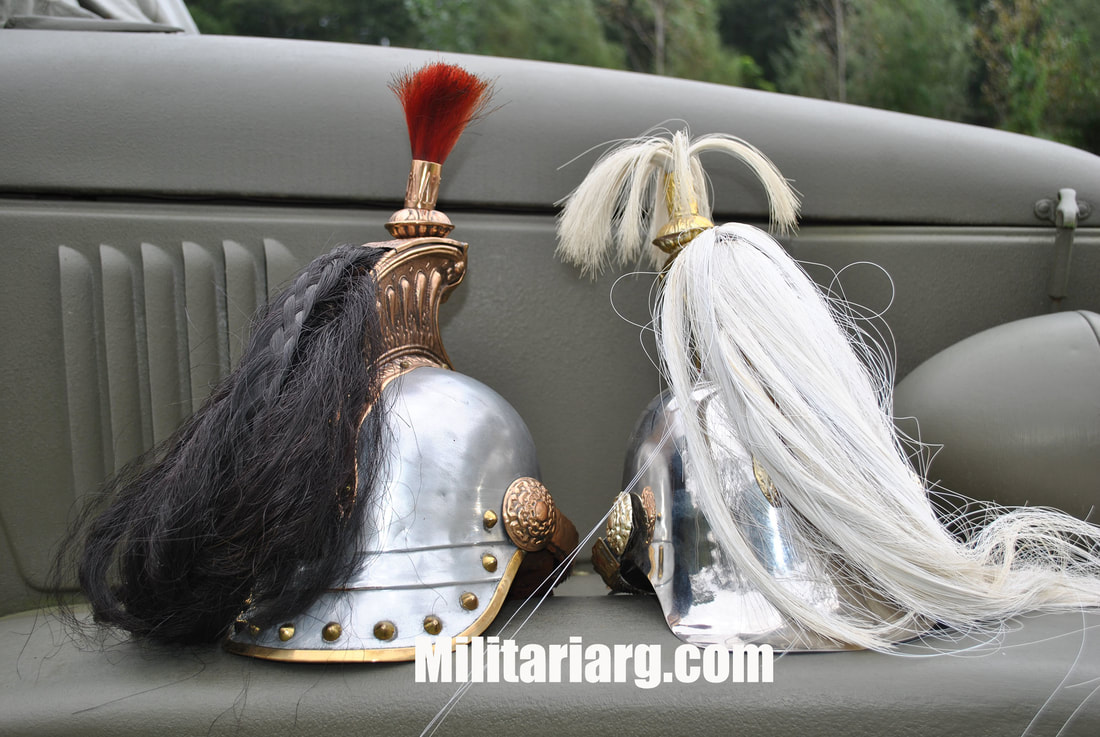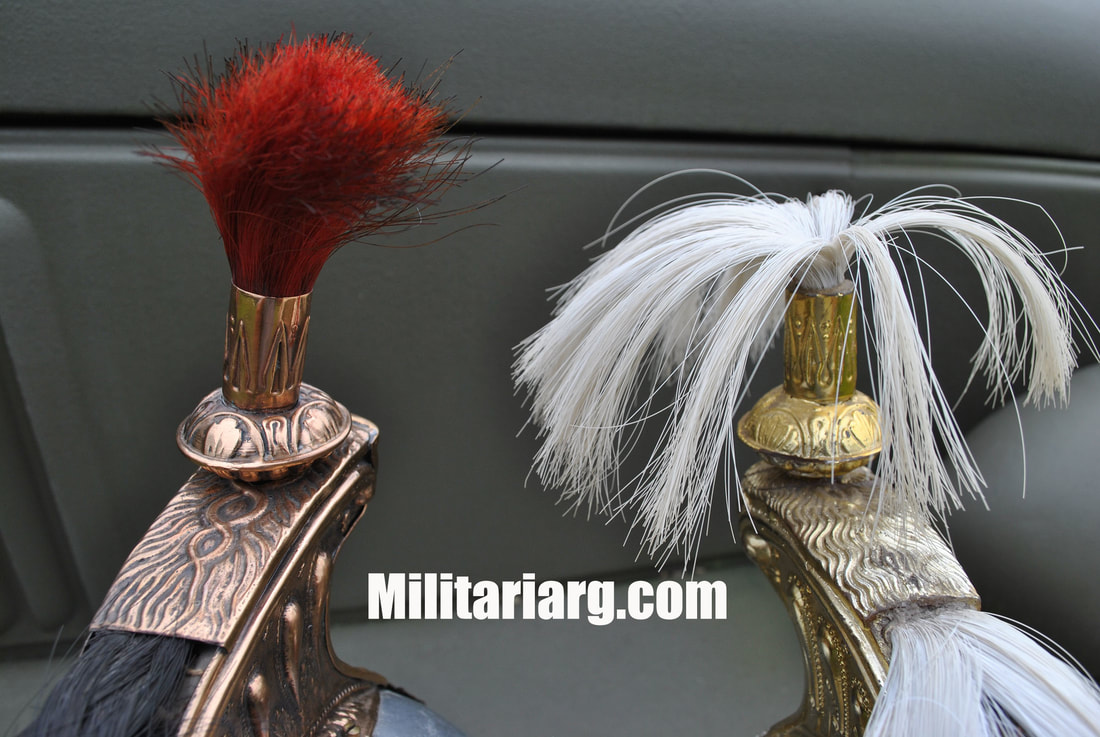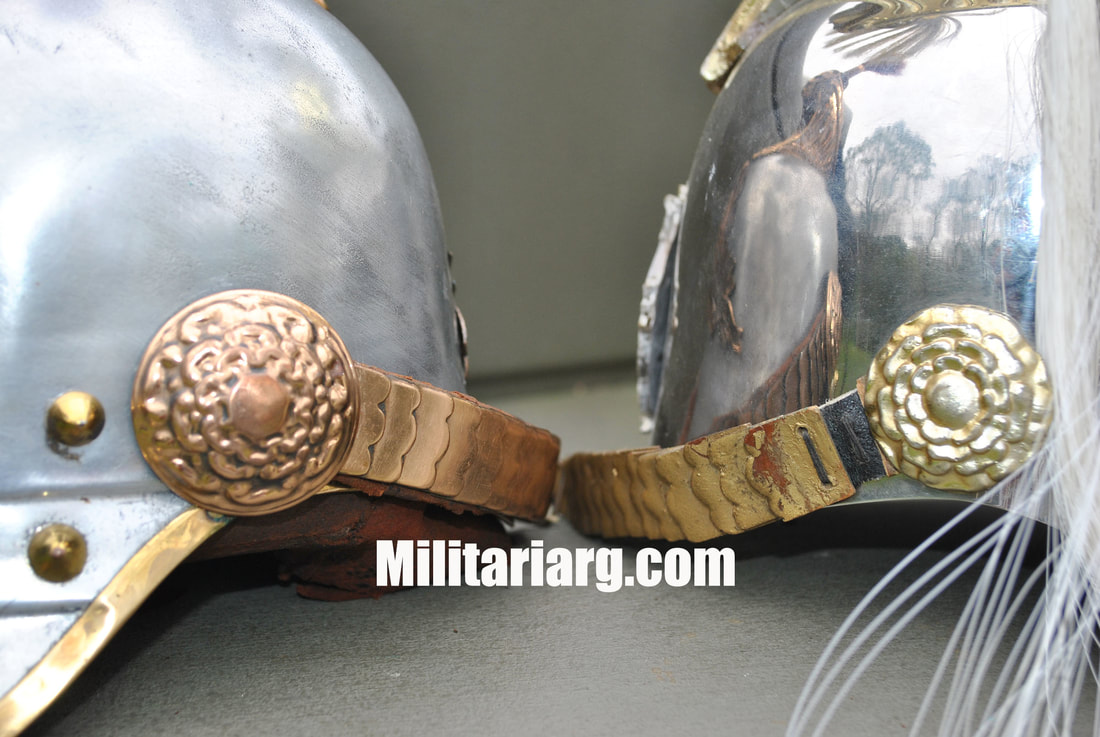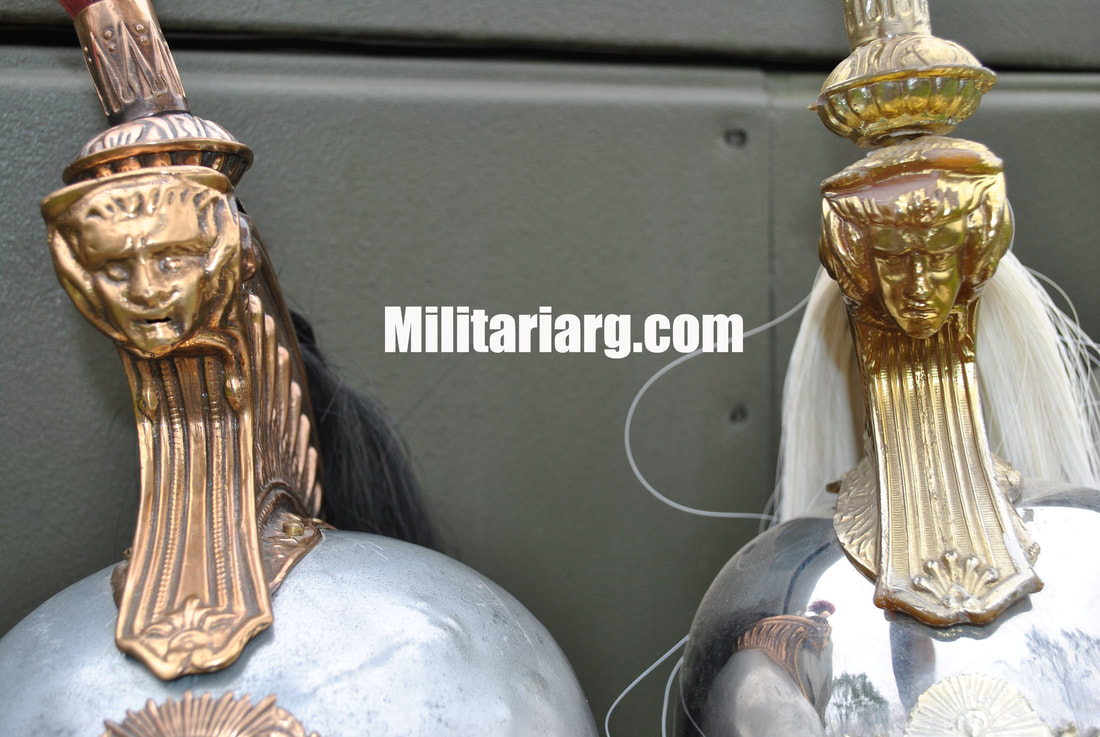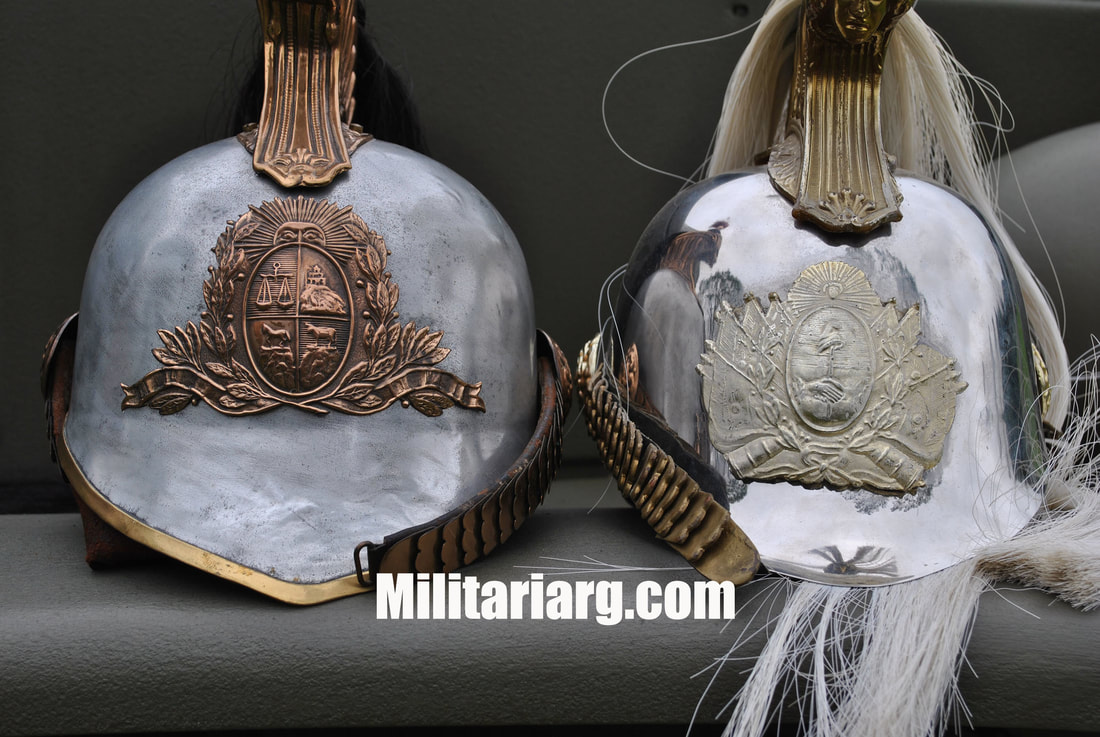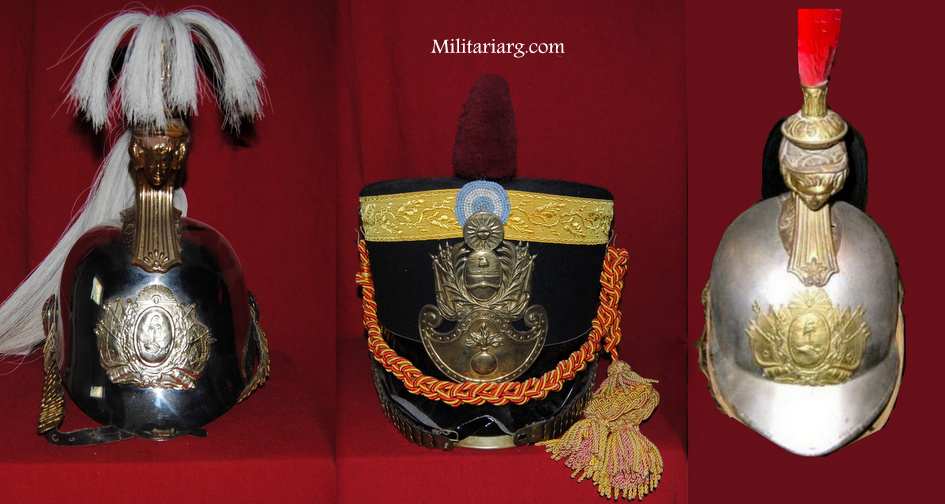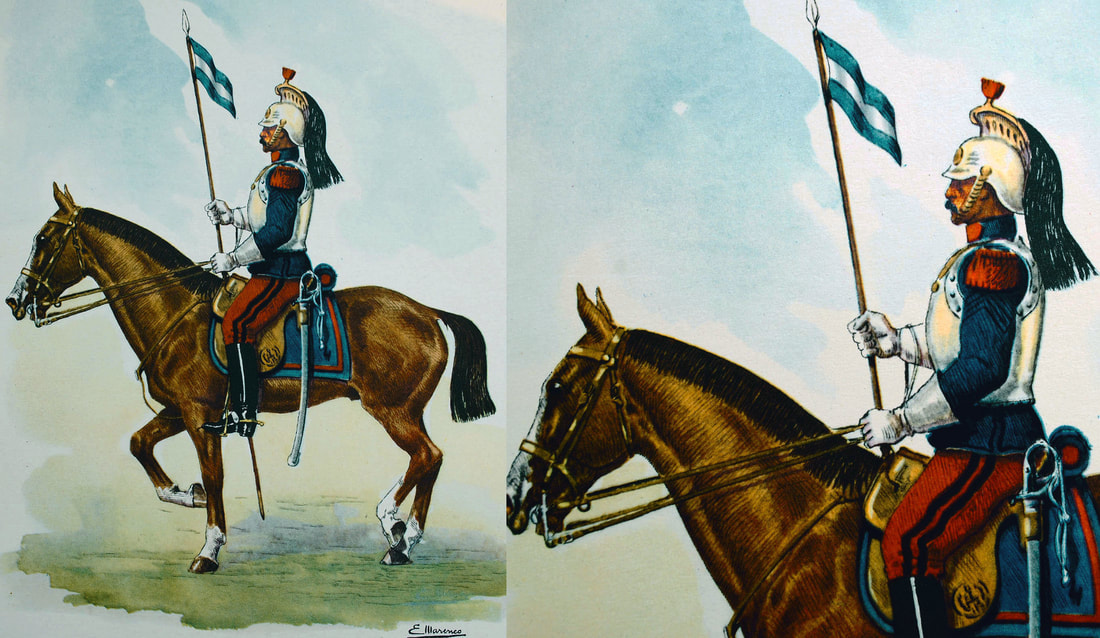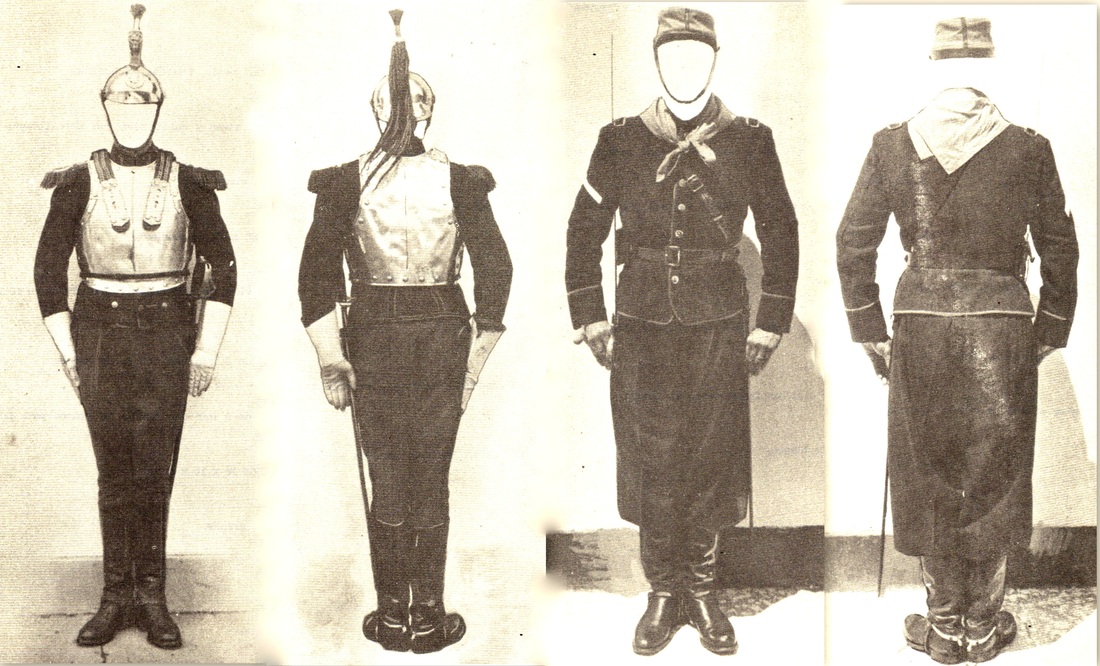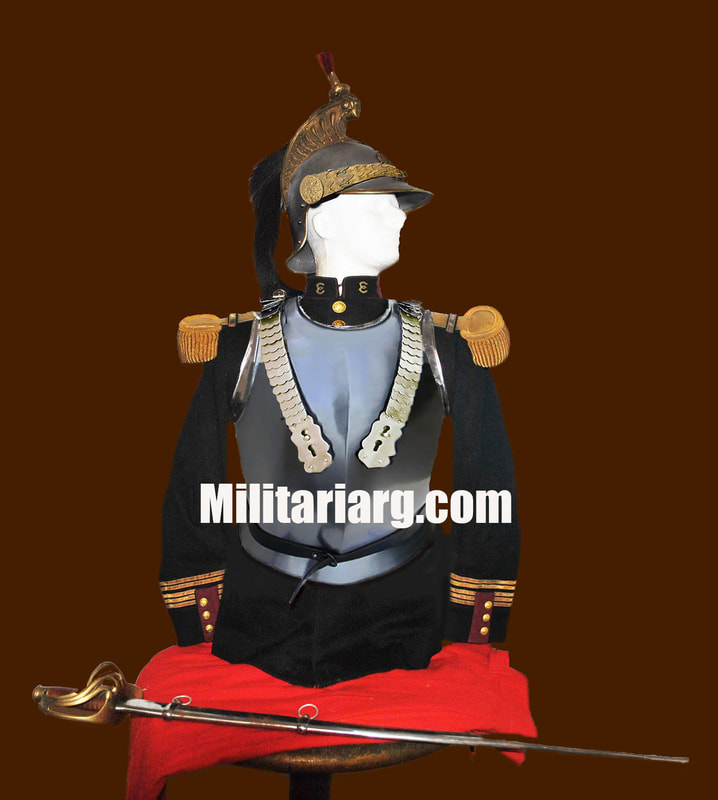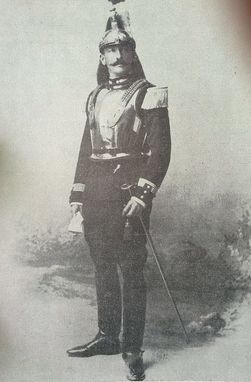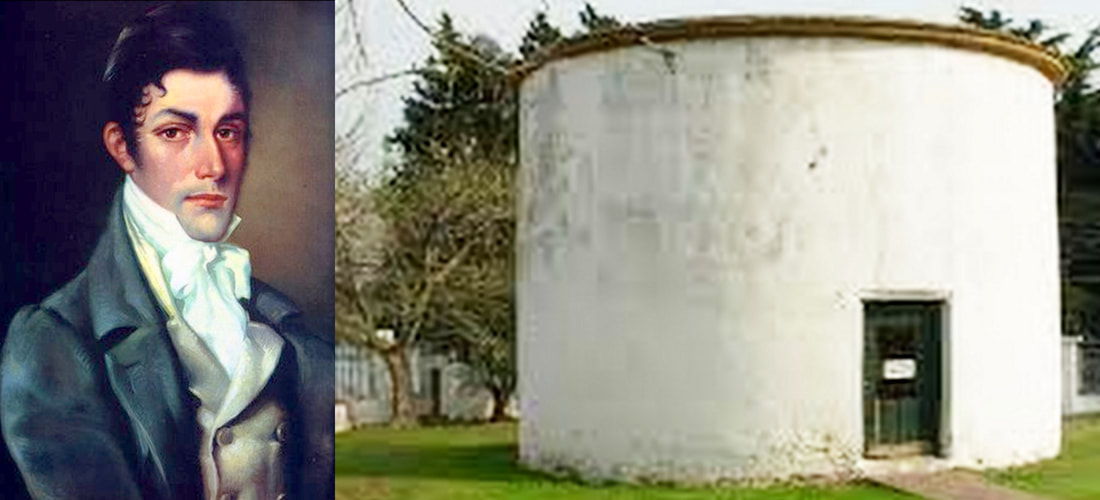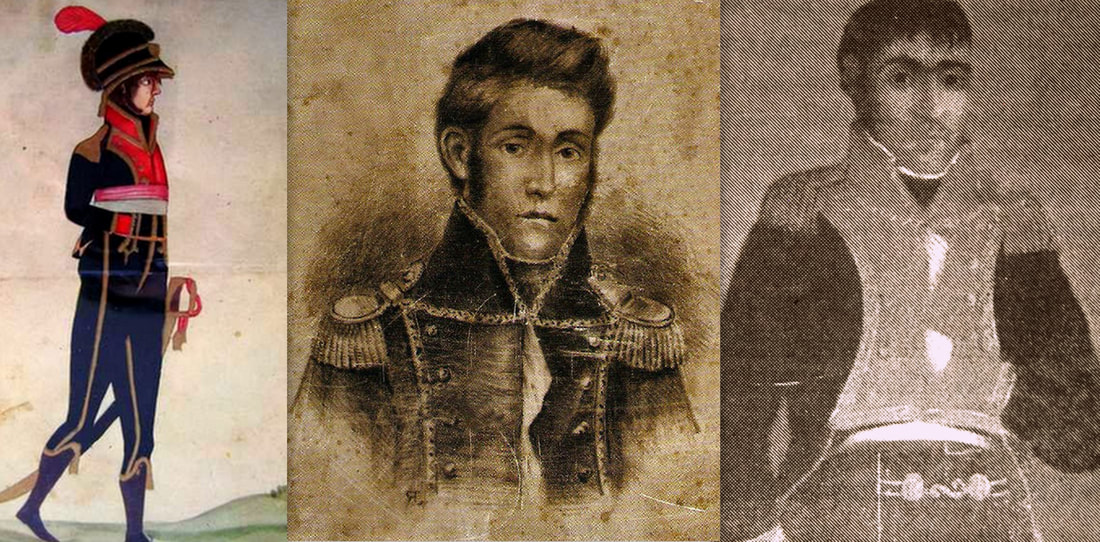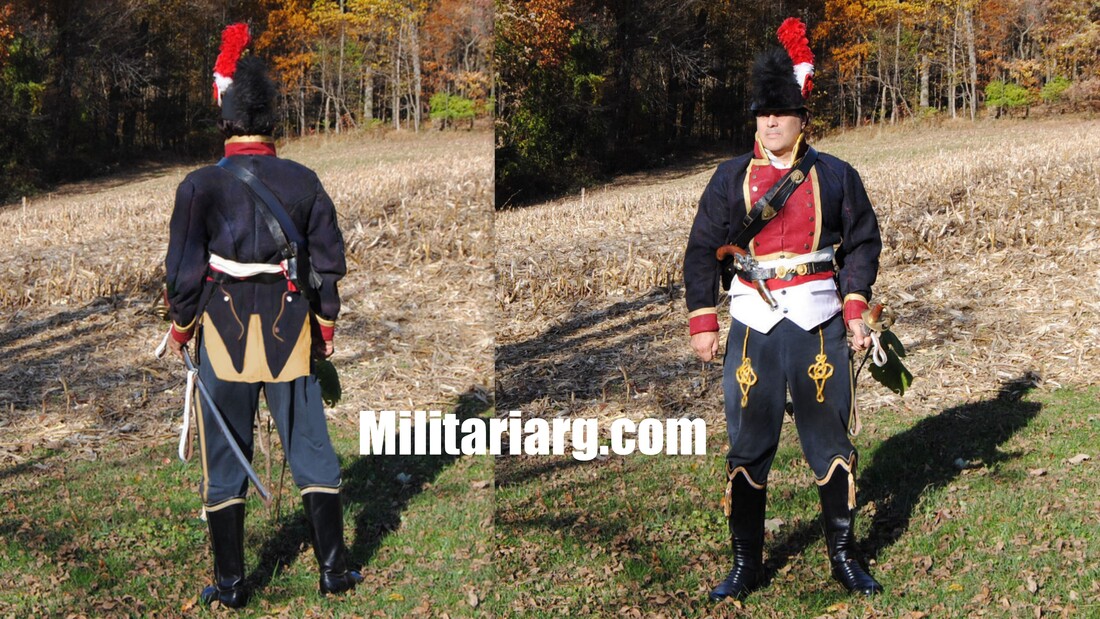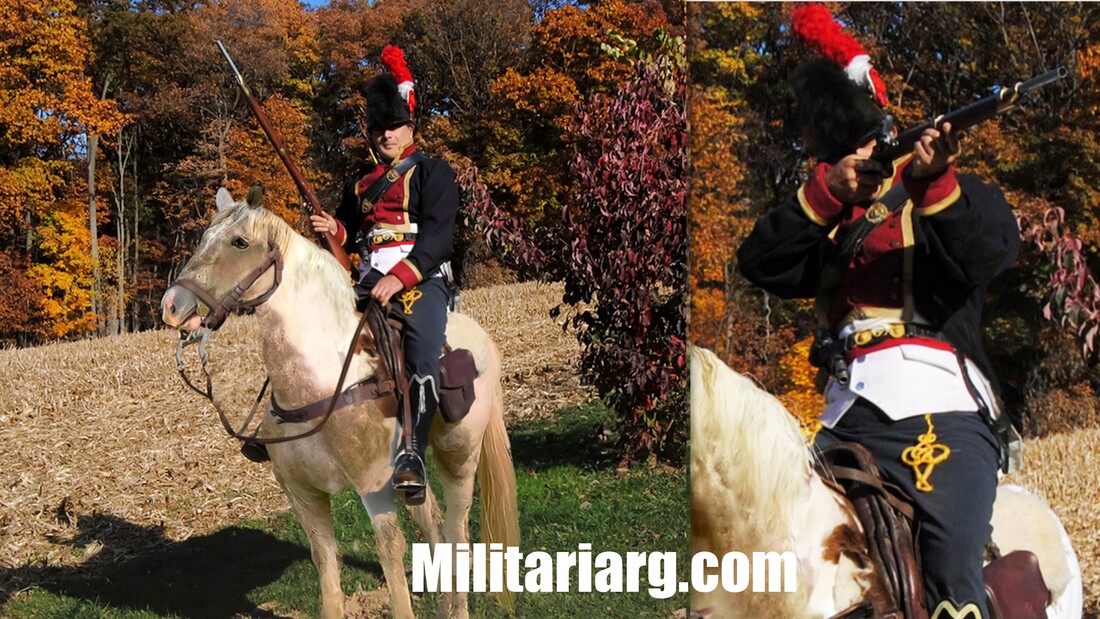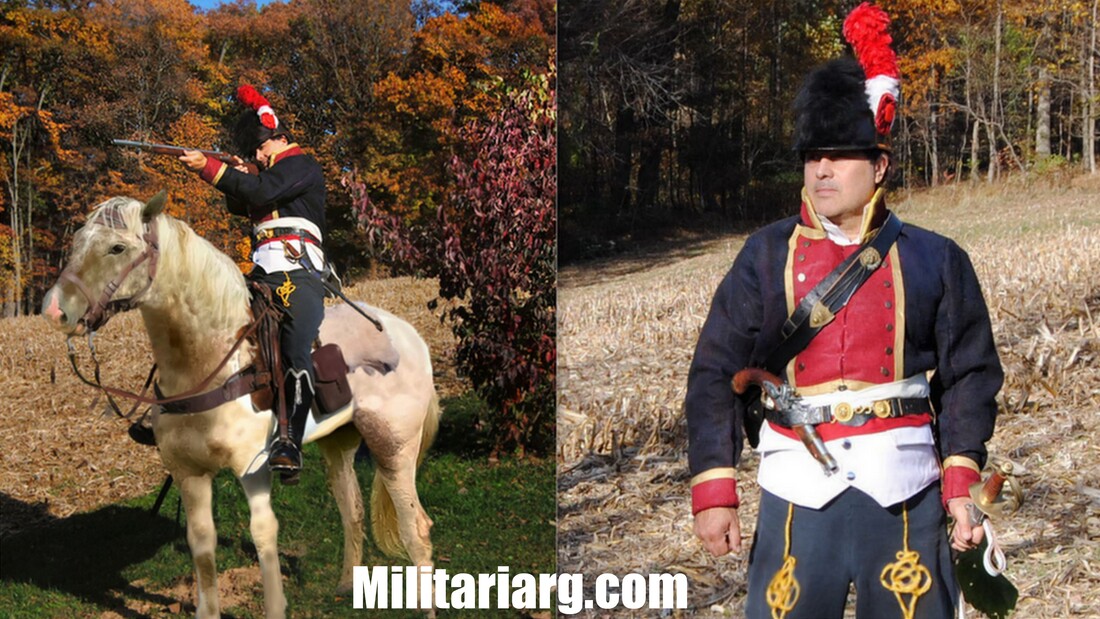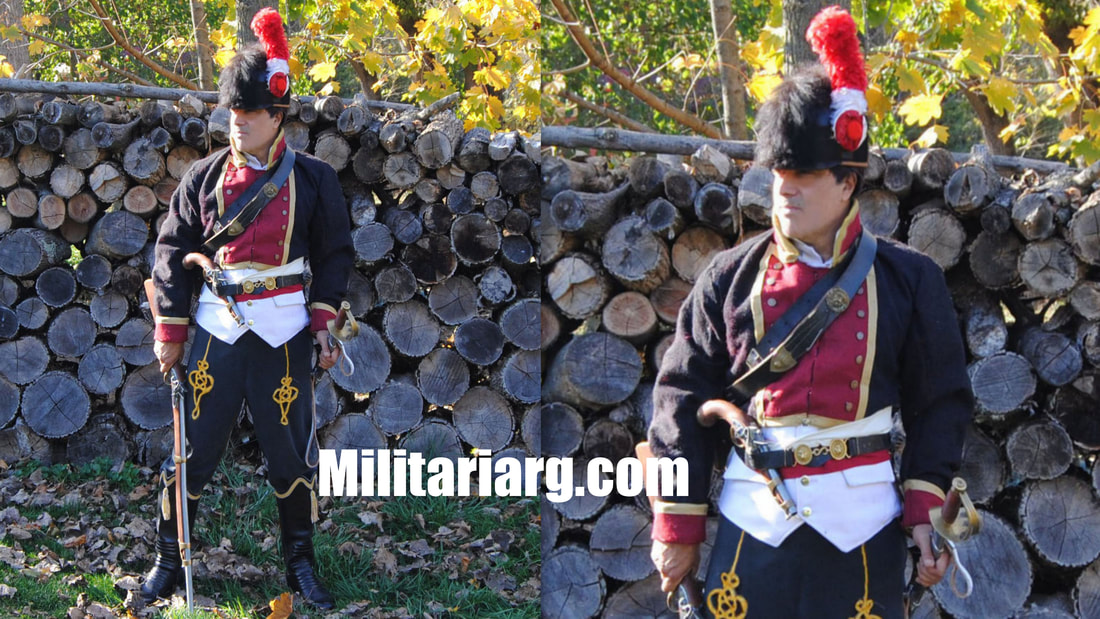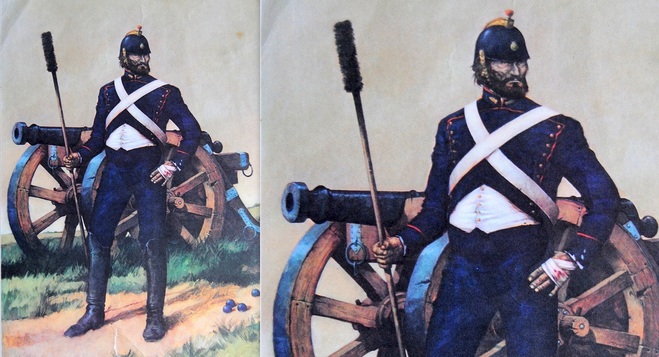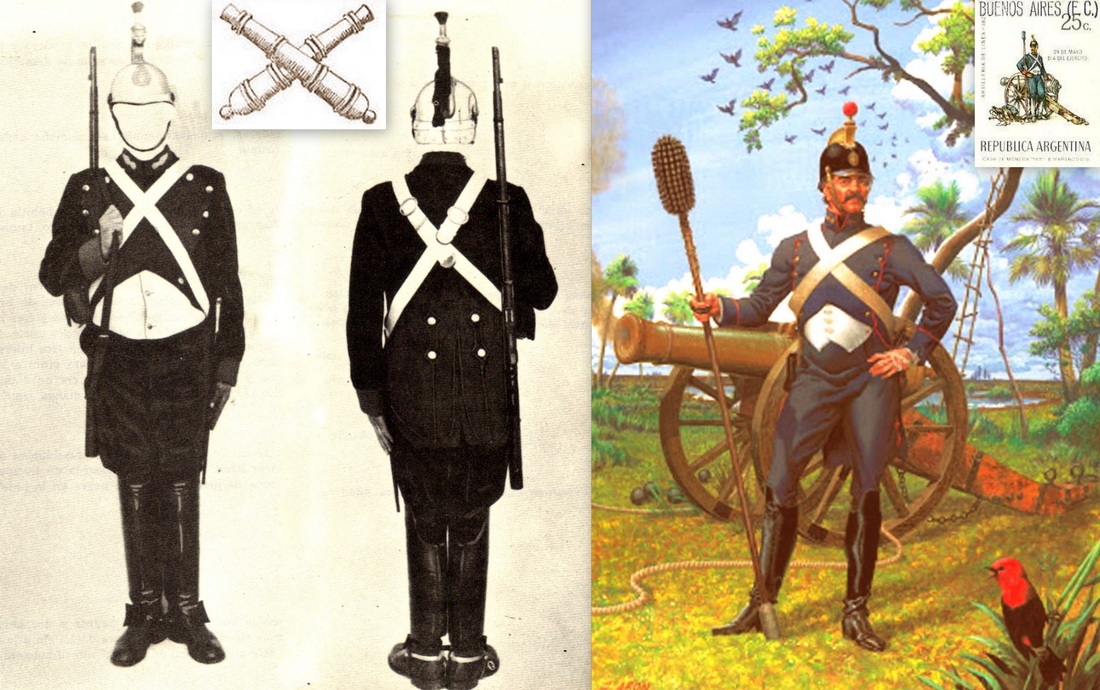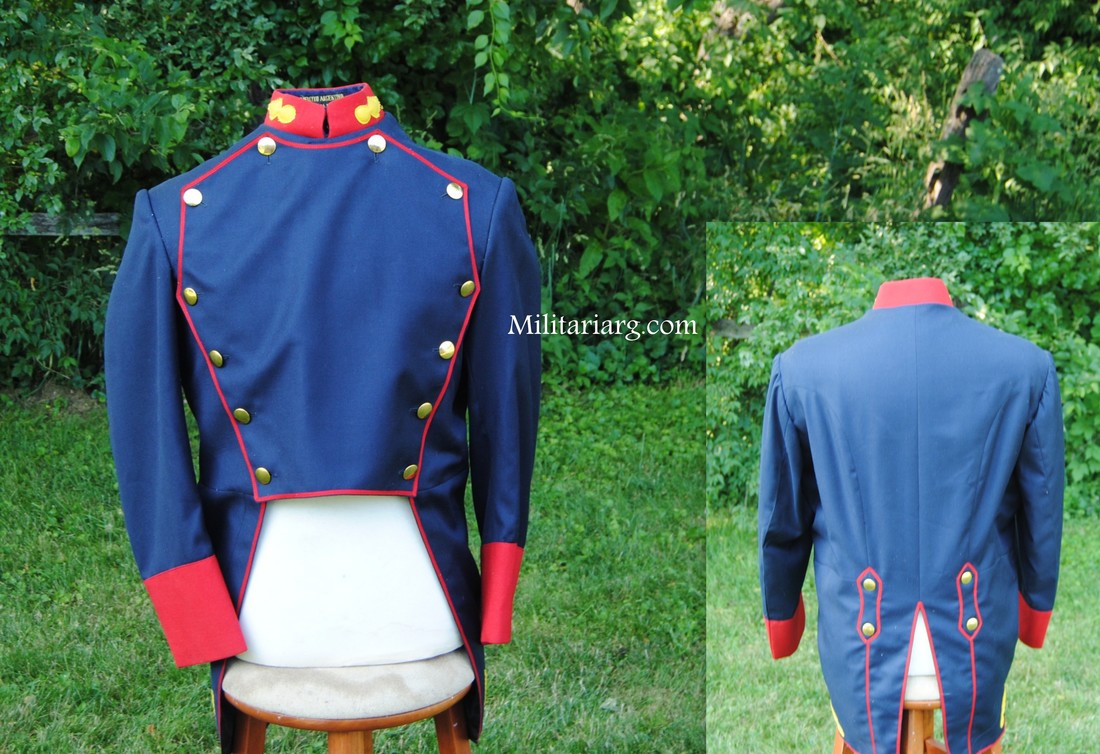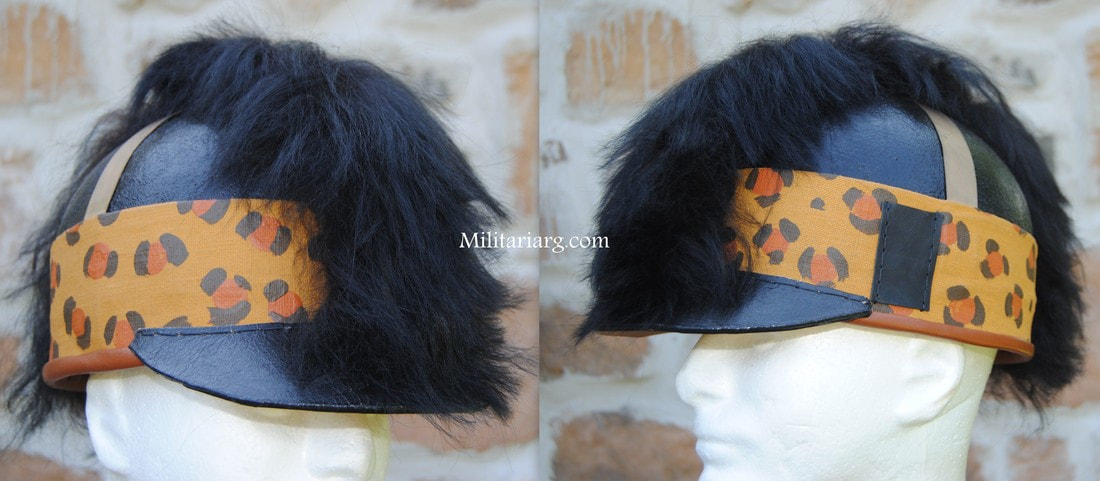Cavalry helmets:
French Cuirass and helmet model 1874. Prussian lance spear model 1895 Solingen. Photo from 1901 "Caras y Caretas".
9th Cavalry Line Regiment (Presidential Escort). Photo Dec 2 1899. Caras y Caretas.
In the 1900s, the 4th Cavalry Regiment was named "Coraceros de Lavalle" in homage to its commander (Colonel Lavalle), during the war against the Empire of Brazil. However, since independence, the cuirassier companies were in each regiment of the line cavalry, as well the mounted carabineers. After the war against Brazil, Argentina was divided into civil wars. General Juan Lavalle represented the Unitary side, and consequently was an antagonist of the Federal Party. For that reason, Lavalle was considered as icon and hero by the victors of the Battle of Caseros in 1852, and for that reason was baptized on the 4th cavalry with his name. However, as the historian Luqui-Lagleyze correctly wrote in his book "The Military Corps in Argentine History", for 1825 - 1828, the time of the war against Brazil, the cuirassiers of the United Provinces of the Rio de la Plata did not wear any kind of steel helmets. But after 1852, the successive governments of Buenos Aires (then a separatist state from the rest of the Argentine Confederation), had cavalry escorts equipped with armor and "Roman" helmets. These helmets, like the uniforms, were all French models. This is the reason why the government escorts in Argentina (the Escort Regiment, the 9th cavalry, and the 8th cavalry successively), dressed exactly like the French cuirassiers from the Second Empire to the Third Republic. At the beginning of the 20th century, the presidential custody was placed under the charge of the Historical Regiment of Grenadiers on Horseback. The French 1872 cuirassier helmets and the model 1872 breastplates that had been used by the 8th Cavalry Regiment went to the 4th Cavalry where it begins to be called "Coraceros de Lavalle". With respect to the cavalry, the model of one of the surviving examples in a museum in Argentina is from the time of the First Empire of France, more exactly from the model 1816 used in Waterloo. During the time of the Argentine Confederation, these steel breastplates were painted black to dull their metallic reflections. Probably also at this time, the hardened leather breastplates began to be used.
With respect to the painting in the photo, I think it is of unknown origin and represents a scene from the Battle of Ituzaingo, where the forces of Emperor Pedro I are defeated. However, the image seems to me more like the tragic charge of the French cuirassiers in Waterloo. The Argentine flag in the drawing is after the War against Brazil, it is rather from the time of the Argentine Confederation.
With respect to the painting in the photo, I think it is of unknown origin and represents a scene from the Battle of Ituzaingo, where the forces of Emperor Pedro I are defeated. However, the image seems to me more like the tragic charge of the French cuirassiers in Waterloo. The Argentine flag in the drawing is after the War against Brazil, it is rather from the time of the Argentine Confederation.
1825 - 1828 War Against the Empire of Brazil. Coracero de Buenos Aires - General Lavalle.
Breastplate cuirass of French origin. Riding breeches over blue troussers. These riding breeches are 18th and 19th century civilian breeches, reinforced with leather. Very common in the corps of cuirassiers of those times. The cuirassier wears a garrison cap and a forage hat. The cavalry uniforms of the time of the war against the Empire of Brazil generally had the same uniforms. The 1st under the orders of Colonel Federico Brandsen, the 4th under the orders of Colonel Lavalle (Cuirassiers), the 5th under the orders of Colonel Federico Rauch (Hussars), the 7th under the orders of Colonel Ramon Estomba
Cuirassier Confederacion Argentina. Colonel Hilario Lagos.
The cuirassier wears a black painted cuirass, very common in the cavalry of those times, since the paint covered the reflection of the metal. He has the French First Empire type Chavari pants, in blue with a red band. He also had them in red, but in the style of the cuirassiers of the Second French Empire. Like the cuirassier of the time of the War against the Empire of Brazil, the cuirassiers of the Argentine Confederation never wore metal helmets, but Shakos did. It is very likely that the appearance of metallic helmets in cavalry, appeared from 1853 in the presidential custody of the Separatist State of Buenos Aires, and these first helmets were of French origin, but firefighters.
8th Cavalry Regiment (Presidential Escort) in 1911.
French made, Argentine Army cuirassier helmet in steel (1899/1900). Uruguayan cuirassier helmet in aluminium (Ex-Argentine Army 1940s) and Cavalry helmet in stainless steel Argentine Mounted Capitol Police (Ex-Argentine Army 1960s).
4th Mountain Cavalry Regiment "Coraceros General Lavalle" and 1st Cavalry Regiment "Coronel Brandsen"
Peruvian Dragoons (Presidential Escort):
On the right: Peruvian Colonel Dogny. On the Left the historic reconstruction of the uniform and equipment of Colonel Dogny. The mannequin wears a Peruvian Dragoon Colonel jacket model 1905 (French Model 1893) and Dragon Cuirassier helmet with marmouset, but without the plummet shown in the photo, the cuirass, and red trousers model 1872. Currently the Peruvian army has this same historical uniform in use in events and parades. It's the uniform of presidential custody. Unlike other armies, the Peruvian army follows even in the smallest details this uniform, with all the original elements of time (the same as the French Dragoons of the Third Republic) such as the French helmet of the French model 1872, and the French jacket model 1893.
Photo of the Colonel Dogny. Source: Wikipedia (Ferrojes): https://es.wikipedia.org/wiki/Escuela_Militar_de_Chorrillos
Photo of the Colonel Dogny. Source: Wikipedia (Ferrojes): https://es.wikipedia.org/wiki/Escuela_Militar_de_Chorrillos
Artilleria de la Union - Real Cuerpo de Artilleria - Artilleria Volante - Horse Light Artillery 1807 - 1811.
Martin de Alzaga. Palomar of the Perdriel Farm, place of the combat in August 1806. Photo: Alepolvorines.com.ar
Horse Artillery Artilleria Volante - Captain Felipe Pereyra Lucena. Buenos Aires 1789 - Alto Peru 1911. Fallen at the age of 22 in the combat of Yuraycoragua, campaign in Alto Peru (Today Bolivia). War of Independence against Spain.
Uniform 1807, of the mounted artillery of Volunteers "Patriotas de la Union (Union of Spaniards and South Americans). Created by Martin de Alzaga on October 8, 1806 to face the invasion of the English troops. These forces trained in the Chacra de Perdriel, where they trained militarily and where they were ambushed by the 71st Highlanders Regiment (Scots), fighting their first combat.Their uniform has Hungarian-style elements, typical of the cavalry, particularly the Hussars, since they were together with the 1st squad of Hussars commanded by Martin de Pueyrredon. Probably this body of horse artillery, was the support of the Hussars of Pueyrredon in guerrilla tactics such as ambushes and skirmishes.
After the English invasions, in 1809 it was elevated to Battalion of Light Artillery framed in the Real Corps of Spanish Overseas Artillery. After the May Revolution, this unit is absorbed as Light Artillery by the Royal Artillery Corps. Within the independence forces, the horse artillery with this same uniform participates in the first campaigns, Expeditions to Alto Peru (Bolivia), Paraguay and the Banda Oriental.
In 1812 the artillery was reorganized creating the Artillery Regiment of the Homeland, whose first uniform is the historical uniform of the artillery weapon.
After the English invasions, in 1809 it was elevated to Battalion of Light Artillery framed in the Real Corps of Spanish Overseas Artillery. After the May Revolution, this unit is absorbed as Light Artillery by the Royal Artillery Corps. Within the independence forces, the horse artillery with this same uniform participates in the first campaigns, Expeditions to Alto Peru (Bolivia), Paraguay and the Banda Oriental.
In 1812 the artillery was reorganized creating the Artillery Regiment of the Homeland, whose first uniform is the historical uniform of the artillery weapon.
French helmets of cuirassiers, as "Historic artillery helmets"
1826 a 8 Cannon; 1st Light Artillery Regiment by Enrique Freccia.
After passing through the 9th and 8th Cavalry Regiment, these French helmets were definitively transferred to the 4th Cavalry, named after General Lavalle. At present the modern versions of these French helmets, model 1872, are used in the historical uniforms of the Regiment 4 of Cavalry, and by Regiment 1 of Artillery. The reason for the helmet use of cuirassier in the historical artillery uniform originates in the practicality of materials, but not in the historical veracity. The original artillery helmet is inherited from the volunteer corps subordinated to the "Royal Artillery Corps". It was a unit of militiamen who organized to defend Buenos Aires from the British invasion of the Rio de la Plata. The helmet used by these Union artillery militiamen, according to the old engravings and descriptions in documents, was nothing more nor less than a French model 1791 Light Infantry Helmet style, with a hard leather body and a metallic or skin crest.
The French type 1791, passes with the royal militias to the light artillery of the independence army of Buenos Aires (the origin of the artillery of the Argentine Army). This type of headgear covering during the War of Independence, is described in the equipment of the Carabineros company of the Horse Grenadier Regiment (Gral San Martin). These carabineros or hunters on horseback had a British "Tarleton" type with a metallic crest, a visor, and a surrounding band of tiger skin. It was used in England by the Light Infantry or Mounted Chasseurs and probably had been part of the British aid to the independence of Latin America from the Spanish domain.
The French type 1791, passes with the royal militias to the light artillery of the independence army of Buenos Aires (the origin of the artillery of the Argentine Army). This type of headgear covering during the War of Independence, is described in the equipment of the Carabineros company of the Horse Grenadier Regiment (Gral San Martin). These carabineros or hunters on horseback had a British "Tarleton" type with a metallic crest, a visor, and a surrounding band of tiger skin. It was used in England by the Light Infantry or Mounted Chasseurs and probably had been part of the British aid to the independence of Latin America from the Spanish domain.
1s Arillery Group "General Iriarte". Historic Uniform.
Historic Artillery jacket, type 1910 Horse Grenadier (French 1858 pattern).
French model 1791, Light Infantry Helmet (Replica). This French helmet would have been of the same type as those used by the real artillery corps during the British Invasions of Buenos Aires, and its subsequent participation in the independence artillery. The English Tarleton, with the band of tiger skin and metallic crest, would have been the pattern used by the carabineers company of the Regiment of Granaderos on Horseback in the Army of the Andes.
